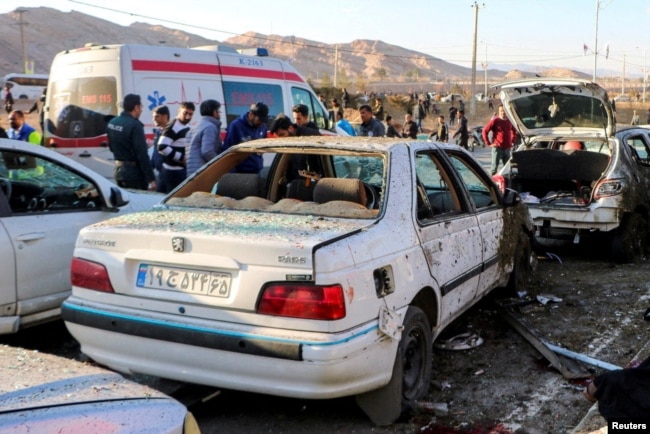VOA – The Iranian government has traced this month’s twin suicide bombings in Kerman city to ethnic-Tajik fighters of the Islamic State Khorasan Province who, experts say, are “fairly small” in number but play “an important part” in the group’s military activities.
The Afghanistan-based branch of the Islamic State (IS-K) claimed responsibility for the January 3 blasts that killed at least 95 people attending the commemoration of the death of Qassem Soleimani, the head of Iran’s Islamic Revolutionary Guards Corps Quds Force, who was killed in a January 2020 U.S. drone attack in Iraq.
A day after the Kerman city attack, top Iranian officials, including President Ebrahim Raisi and IRGC Commander Hossein Salami, claimed that Israel and the U.S. were behind the attack, without offering any evidence.
But a week later, the Iranian intelligence ministry said in a statement that one of the two bombers was a citizen of Tajikistan who received training at an IS-K camp in Afghanistan and crossed to Iran illegally via its southeastern border.

The statement did not name the second suicide bomber but said the mastermind of the attack was also a citizen of Tajikistan who left Iran after planning it.
The number of Tajik citizens in IS-K is “fairly small,” said David Sedney, former U.S. deputy assistant secretary of defense for Afghanistan, Pakistan and Central Asia, adding, “but they are, I understand, a fairly large portion of the more aggressive and successful fighters.”
Sedney told VOA that Tajik fighters are well-trained and important to IS-K’s military operations.
Tajik fighters are “a very important part of the Daesh military wing, capable of carrying out suicide attacks and other military activities,” said Sedney, using another name for the Islamic State, which is also known as IS or ISIS.
Formed in 2015, IS-K is an offshoot of the Islamic State in Iraq and Syria which, according to a June 2023 U.N. report, is “the most serious current terrorist threat in Afghanistan, neighboring countries and Central Asia.”
The report estimated IS-K’s fighters and their families number between 4,000 to 6,000, including citizens of Central Asian countries.
Bill Roggio, a senior fellow at the Foundation for Defense of Democracies, told VOA that though the exact number of Central Asians, including Tajiks, in IS-K is not known, they could be in the hundreds.
Roggio, however, said that the Islamic State has “always been effective in poaching … disaffected” members of the other militant groups based in Afghanistan.
The U.N. report said there are around 20 militant groups in Afghanistan, including Jamaat Ansarullah, a Tajikistani extremist group, also known as Tajik Taliban.
“The Islamic State is a natural place for individuals who want to get their jihad on now, and aren’t, you know, afraid to be bold and attack China or attack various places,” Roggio said.
He added that the Persian-speaking militants are an asset for the IS-K.
“They certainly would leverage individuals who could speak Farsi, who could operate a little bit more easily in Iran for certain,” Roggio said.
Islamic State is a Sunni extremist group that considers majority-Shiite Iran as its enemy.
Roggio said that he does not think the Islamic State could pose a significant threat to Iran, but the group can carry out terrorist attacks.
The Islamic State also claimed an attack on a religious shrine in the Iranian city of Shiraz in October 2022, killing 15 people. IS-K is a major rival to the Taliban and carried out several high-profile attacks after the Taliban took power in Afghanistan.SEE ALSO:Islamic State Claims Responsibility for Iran Explosions That Killed 84
Addressing a press conference in Kabul last month, Taliban defense chief Mohammad Yaqoob Mujahid claimed that most of the attacks in Afghanistan were carried out by Tajik and Pakistani nationals.
He also claimed that the Taliban’s security forces killed dozens of Tajiks and more than 20 Pakistanis, and asserted the number of IS-K attacks has decreased by 90%.
Tajik writer and political analyst Sherali Rizoyon told VOA that the Kerman suicide bombers were trained in Afghanistan, and it “either refutes the Taliban’s claim that they are in full control of Afghanistan or shows that the Taliban have relations with such groups.”
A U.N. report released in June said members of the Tajik militant group Jamaat Ansarullah helped Taliban fighters battle anti-Taliban resistance forces in the northern provinces of Afghanistan.
Ghaws Janbaz, former Afghan ambassador to Moscow, told VOA that the Taliban’s return to power has inspired militant groups throughout the region.
“The Taliban’s takeover has encouraged and motivated them,” said Janbaz, adding that “the Taliban claim that they defeated the superpower in Afghanistan so these [militant groups] think that they can easily defeat the governments in the region.”
This story originated in VOA’s Afghan Service.
 Shabtabnews In this dark night, I have lost my way – Arise from a corner, oh you the star of guidance.
Shabtabnews In this dark night, I have lost my way – Arise from a corner, oh you the star of guidance.



